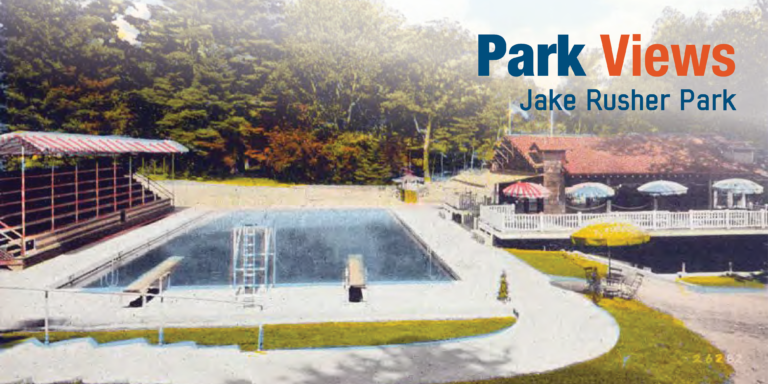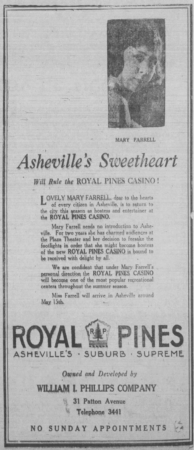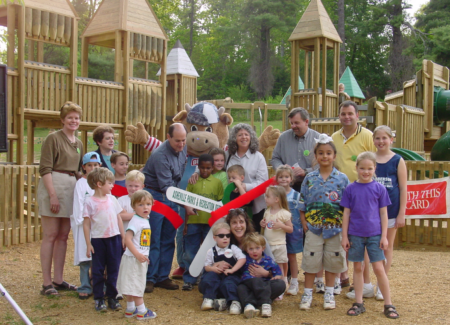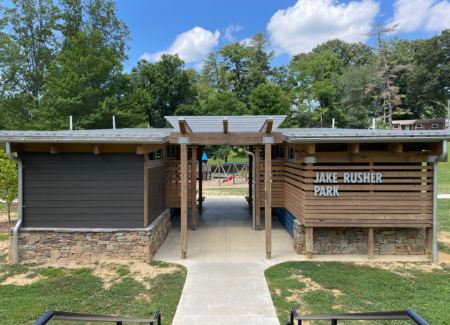This entry is part of Park Views, as Asheville Parks & Recreation series that explores the history of the city’s public parks and community centers – and the mountain spirit that helped make them the unique spaces they are today. Read more from the series and follow APR on Facebook and Instagram for additional photos, upcoming events, and opportunities.
Jake Rusher’s Royal Pines Casino and Pool was known as the “beach club of the mountains” for decades, hosting top music acts and acting as backdrop for summer memories. After years of watching generations of kids grow up at the pool, he approached Asheville Parks & Recreation (APR) to establish Jake Rusher Park when he retired.
Buncombe Turnpike
The Asheville area experienced slow, but steady growth following arrival of the first European settlers with around 1,000 residents counted by the first United States Census in 1790. This number excluded the Cherokee who inhabited the region for thousands of years prior and built villages along the Swannanoa and French Broad rivers whose confluence was called ᏙᎩᏯᏍᏗ (Togiyasdi, “the place where they race”).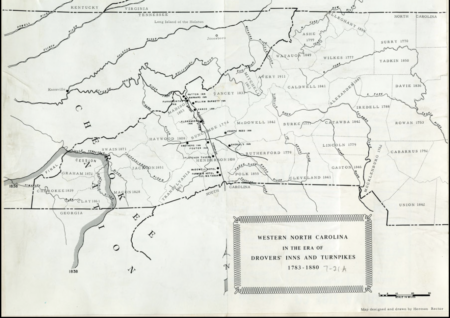
While trappers and frontiersmen used Cherokee trails and paths left by wild animals to navigate gorges and peaks in the mountains, they were largely insufficient for homesteaders and traders moving goods to market. As the foothills of Tennessee became major areas for raising cows, sheep, fowl, and hogs, a more efficient way to move livestock to more populated coastal cities including Charleston and Augusta was needed.
In 1819, the North Carolina General Assembly created the Board of Internal Improvements to build roads for improvement of trade and regional growth. The construction of Buncombe Turnpike came from the board’s plans to link two separate towns named Greenville in Tennessee and South Carolina. Completed in 1828, it brought new settlement, commercial trade, and tourism to western North Carolina.
The 75-mile artery roughly followed the same path as present-day U.S. 25 through Buncombe County, joining the gentle grade of the French Broad near the current intersection of Broadway and Riverside Drive. As summer visitors from the coast traveled to Asheville in the comfort of carriages instead of wagons, points along the turnpike developed into popular resorts and boarding houses. These affluent families changed the landscape of the area as they built vacation homes among small fields owned by local farmers.
Royal Pines: Asheville’s Suburb Supreme
Daniel Blake was one of the first Charleston plantation owners to settle in the area, building an estate home on 950 acres in the 1820s. He sold nearly 300 acres of his land in 1847 before buying it back in 1852, at which point a Gothic Revival house was built on it. It passed to his son and later granddaughter before she sold the house and 516 acres surrounding it to the William Phillips Company of Miami in 1925.
The new owner turned the land into a subdivision called Royal Pines, named for the white pine trees lining the carriage road to The Blake House that became the center of the neighborhood. Described as “a suburban city in the heart of a beautiful and healthful environment for those who crave life in these charming mountains,” ads for Royal Pines promised electric light and power, telephone service, paved roads, and a water and sewer system, as well as parks and a recreation center with a private swimming pool, tennis courts, and nightclub. A promotional song called “Everybody’s Pining for a Home in Royal Pines” was played during concerts at the company’s downtown offices.
The Royal Pines Casino and a spring fed pool opened in 1926 with appearances by Olympic swimming champion and iconic Tarzan actor Johnny Weissmueller. However, during the Great Depression, many lots were abandoned as buyers could no longer pay their mortgages. The William Phillips Company defaulted on its loan in 1940 and remaining undeveloped property was sold to a new developer, Parkway Properties.
During World War II, the casino and swimming pool closed. It remained vacant until Jake Rusher purchased the complex in 1947.
The Pines
A Navy veteran, Rusher owned and operated Weeping Willow Pool in Hendersonville, but remarked he had a hankering for the nightclub business. The son of one of Henderson County’s largest landowners, other business ventures included the Jade Club in Asheville and A&H Airport Raceways on the site of the old Asheville-Hendersonville Airport, one of the nation’s largest drag strips.
The casino and swimming pool were immediately popular entertainment destinations for teens and young adults from Asheville and surrounding areas, attracting many soon-to-be-famous bands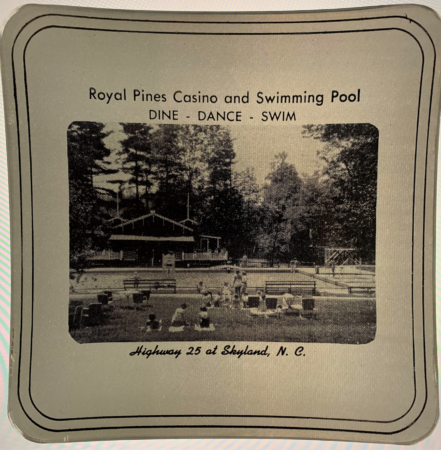 over the following decades including Bo Diddley, Percy Sledge, The Drifters, and The Supremes. Local musicians and tunes from a jukebox also kept people dancing on the large maple hardwood dance floor, described by Rusher as the largest in western North Carolina. He built a home across the street from the park so he could always be close to his business.
over the following decades including Bo Diddley, Percy Sledge, The Drifters, and The Supremes. Local musicians and tunes from a jukebox also kept people dancing on the large maple hardwood dance floor, described by Rusher as the largest in western North Carolina. He built a home across the street from the park so he could always be close to his business.
In 1961, the casino/dancehall/social club was renamed The Pines, while the pool, concessions building, and gameroom remained known as Royal Pines swimming pool. The seasonal outdoor pool fostered a family-friendly atmosphere during the day.
While there are no shortage of tales of teens sneaking adult beverages or young couples staying out past curfew, Rusher enforced a dress code and a strict “couples only” rule at the dancehall. However, Buncombe County’s first violation of a new “brown-bagging” law took place at The Pines in 1967 when a captain with Buncombe County Sheriff’s Office entered disguised as a hippie and saw minors drinking beer. After the arrest, the captain told the band to keep playing.
Changing Times
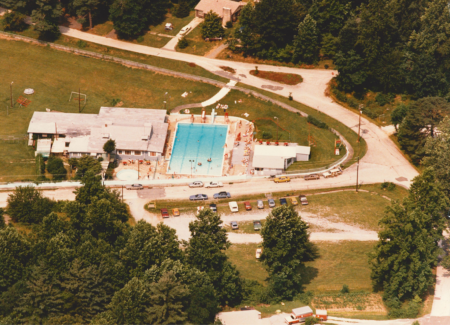 The Pines grew with a number of building additions through the 1970s. As rock and disco displaced patrons’ taste for rhythm and blues, the nightclub shut down and the building was leased to the Women of the Moose to use as a bingo hall. Of his long-discarded “couples only” rule, Rusher said, “It’s a singles world now.”
The Pines grew with a number of building additions through the 1970s. As rock and disco displaced patrons’ taste for rhythm and blues, the nightclub shut down and the building was leased to the Women of the Moose to use as a bingo hall. Of his long-discarded “couples only” rule, Rusher said, “It’s a singles world now.”
The pool was rebuilt in the 1970s and a video arcade, pool table, and foosball kept kids and teens entertained during swim breaks. Rounding out the park were swings in the picnic area and a wading pool for toddlers. As skateboarding gained popularity, Rusher added skate and bike ramps on the south side of the park to create a safe place for kids to practice their sport out of the streets. In an interview at the time, he remarked, “When you stay around young people, you stay young.”
As the pool celebrated 50 years under Rusher’s ownership in 1997, he approached the City of Asheville to convert the space into a public recreation park, one of the only such spaces in south Asheville. APR managed Lake Julian Park when it originally opened, but transferred those duties to Buncombe County in the 1970s. South Asheville experienced tremendous growth since that time, but no new parks had been built in the area.
Rusher donated the property to a charitable remainder trust that negotiated the sale of the property to Trust for Public Land (TBL), a nonprofit land conservation group. All proceeds of the sale were placed in the charitable remainder trust from which Rusher could draw living expenses. During that time, the City of Asheville bought the land from TBL for just under $1 million. Upon his death, Rusher’s remaining estate was divided between TBL and APR for upkeep of the new park.
Jake Rusher Park
Asheville Fire Department held a controlled burn of The Pines building for training in 2000 and a large playground was installed in its place with swings, slides, bridges, walkways, and turrets. Most of the park remained open greenspace for impromptu volleyball, football, and lawn bowling games.
Rusher passed away in 2003 and the next year, Arden and Biltmore Forest Rotary clubs hosted the first of a few Rock’n the Mountains music festivals. An homage to the music and dancing the spot had been known for, it also helped raise funds for a pavilion in the park.
As part of the 2016 parks and recreation bond referendum, Jake Rusher Park received new parking, accessible sidewalks, outdoor sports courts, pavilion and restrooms, improved lighting, new landscaping, a walking loop around the perimeter, and relocation of utilities underground – ensuring this space continues to meet the recreational needs of future generations.
Do you have photos or stories to share about Jake Rusher Park? Please send them to cbubenik@ashevillenc.gov so APR can be inspired by the past as we plan our future.
Photo and Image Credits
- A 1927 postcard of Royal Pines Casino advertised the subdivision as “Asheville’s Suburb Supreme.” Though the term is associated with gambling in current usage, it more commonly meant a social club in the early 20th century. Courtesy of Buncombe County Special Collections, Pack Memorial Public Library, Asheville, North Carolina.
- This map drawn by Herman Rector shows Buncombe Turnpike’s path through Henderson, Buncombe, and Madison counties with inns along the way. Courtesy of Buncombe County Special Collections, Pack Memorial Public Library, Asheville, North Carolina.
- Appearing in the The Asheville Times on May 7, 1926, this advertisement promised a summer of fun and recreation hosted by Mary Farrell. Despite its location approximately nine miles south of downtown Asheville, Royal Pines was among the city’s rapidly expanding residential sections. More fully realized neighborhoods of the period including Kenilworth, Beverly Hills, Biltmore Forest, Lake View Park, and sections of West Asheville benefitted from their proximity to the city center. Although Royal Pines posted strong lot sales in the 1920s, few homes were constructed prior to 1940. Improved transportation allowed for increased suburbanization in the second half of the 20th century and brought significant growth to the southern portion of the county that ultimately precipitated the full development of Royal Pines. As a result, Royal Pines more closely resembles the residential neighborhoods of the second-half of the 20th century instead of its early counterparts.
- Many souvenirs of the park’s former life survive in local’s collections including matchbooks, brochures, posters, and this ashtray.
- An undated photo shows Royal Pines swimming pool near the end of its life. A picnic area and playground are in the upper left of the property next to the casino that had seen multiple additions over the years. Next to that building is a wading pool and larger pool with low and high dives and a 20 foot slide. The smaller structure is the concession building and game room.
- The giant wooden playground was constructed with volunteers from Rotary clubs and other community organizations, as well as neighbors and individuals.
- In 2021, Jake Rusher Park received a number of upgrades including a shaded pavilion with restrooms next to the playground.
